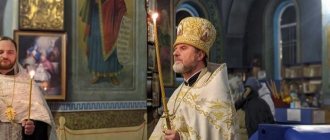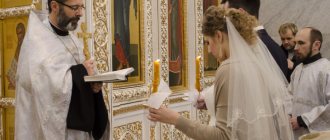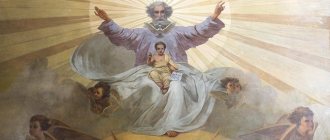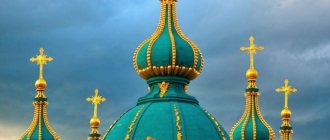From the editor : How did episcopate arise in the Ancient Church? What was the procedure for nominating bishops? By what criteria were candidates for bishops selected, and what participation did the community take in this? We offer an article by historian Kiril Mikhailov.
***
The episcopate is the most important basis of the church structure - both in its special administrative functions and in its spiritual dimension. The word “επίσκοπος” translated from Greek means “overseer”, “keeper of order”. This is the highest level of the church hierarchy - it is bishops who are the bearers of apostolic grace, the gifts of the Holy Spirit. Issues of apostolic succession, ideological harmony of the episcopate, and internal subordination are among the most important in the life of the church community. These issues can lead to both civil wars and civilizational conflicts. In the history of the Russian Old Believers, the most important problem was the episcopal question; it led to the internal drama of the entire community of adherents of ancient piety - a division into two irreconcilable ideological camps: priests and non-priests. Since the non-priests, after the death of Bishop Pavel Kolomensky, no longer saw pious archpastors in Rus' or anywhere in the world, the possibility of ordaining new priests disappeared, and after the death of all the priests who did not support Nikon’s reform, the possibility of performing the most important sacraments for Christian life also disappeared - for example, Marriage and Eucharist. As a result, among the Bespopovtsy there was no universal agreement on these issues, which are the most important for the spiritual life of every Christian, which led to further demarcation of the Bespopovtsy. Thus, the most morally strong and spiritually healthy part of Russian society was unable to consolidate against secular church-state measures and was pushed to the periphery of socio-political life - both figuratively and geographically.
Bishops of the Russian Orthodox Old Believer Church, now deceased. Photo from the archive of Priest John Gusev
Thus, the bishop is not just an administrator, he is also the spiritual leader of the church community, its moral guide. For the Christian consciousness, these three dimensions of episcopacy - mystical apostolic succession, organizing functions and spiritual fatherhood - are linked together, and the question of any one of these aspects cannot arise in isolation from the other two.
The bishop is the center of church life. But he is not the whole Church and not even the community. It is important to trace how the institution of episcopate was formed, how it transformed over time, and what lessons its history can teach us.
How did the episcopate arise?
The word “bishop” itself is not of Christian or even religious origin. In Roman legal literature, the term is found in different senses, and was not always used in relation to pagan priests, high or even ordinary. Thus, there were “bishops” among the ministers at the Temple of Apollo of Rhodes, there were officials in charge of collecting funds, there were inspectors in the Athens Maritime Union. Often, “bishops” were the name given to overseers of various kinds: over conquered territories, over construction work, over slaves, over market trade in markets.
In the Holy Scriptures, the word “bishop” occurred in the Old Testament (2 Ezra 9: 39-40), from where it was later borrowed by the apostles. The Savior Himself in Holy Scripture is called “bishop,” which means “guardian of our souls” (1 Peter 2:25); “Bishop,” “High Priest” (Heb. 4:14; 7, 26). The apostolic title was not used in practice, being replaced by the concept “bishop” (Acts 1:20). From the apostles the title of bishop was transferred to their immediate disciples. St. Clement of Rome describes the “creation” of the episcopal rank by the apostles: “preaching in various countries and cities, the first-born of the believers, after spiritual testing, were appointed bishops and deacons for future believers” (1 Epistle).
As the early Christian communities grew, the need for an organizing principle arose - this is described in detail in the Apostolic Epistles, especially in St. Paul. Already under the first Apostles—witnesses of the Resurrection and Ascension of the Savior—the first false teachers appeared, including “those who love to take precedence” (3 John 1:9). Therefore, the significance of the overseer bishop was that he combined administration, doctrinal authority, and high moral standards.
The three-tier church structure (bishop-presbyter-deacon) developed in the Apostolic Church. But often, when reading Holy Scripture in isolation from Church Tradition, one may get a wrong idea about the two-part nature of the ancient clergy: often the terms “presbyter” (priest, priest) and “bishop” (bishop, chief) are used as synonyms. Protestants take advantage of this fact, asserting the relativity of the early church hierarchy. This is partly true: the Holy Apostles were not bureaucrats, and both the bishop himself and authoritative priests could be called “first” in any community. And vice versa: both priests themselves and bishops were called “presbyters”; in small communities they continued to perform ordinary priestly activities. And according to the logic of things: a bishop is not someone outside the clergy - he is a priest in almost all his fullness, an almost absolute conductor of the grace of the Holy Spirit. “Almost” - because the complete, absolute guide is the Savior Himself, as the Apostle Paul calls him: “This is what our High Priest should be: holy, free from evil, blameless, separated from sinners and exalted above the heavens, who has no need daily (...) to offer sacrifices first for his own sins, then for the sins of the people, for He did this once, sacrificing Himself. For the law appoints as high priests those who have infirmities; and the word of the oath, after the law, established the Son to be perfect forever” (Heb. 7:26-28).
However, if we turn to the written part of the Holy Tradition - to the Apostolic rules and regulations, to the letters of the Holy Fathers, we will see that the ancient Church from its very foundation on the day of Pentecost had the same structure as today.
Who is a bishop in the Orthodox tradition
This is a synonymous concept, used as often and in the same meaning as “hierarch”, “archpastor”. He is a dignitary of the Orthodox Church. A clergyman of this rank performs all the sacraments and leads the life of the church community.
In accordance with Christian doctrine, the archpastor, through the sacrament of ordination, receives apostolic grace received from Jesus Christ. In the Russian Orthodox tradition, representatives of the monastic clergy reach such heights of hierarchical levels, since it is obligatory for them to observe the vow of celibacy.
Origin of the word
The word “bishop” comes from the ancient Greek “high priest, high priest” (“archi” - beginning, superior; “priest” - priest).
Meaning of the concept
Archpastoral service is akin to schema tonsure and involves complete renunciation of one’s own will. All hierarchs (with the exception of vicars) govern the dioceses. In ancient times they were divided into bishops, archbishops and metropolitans according to administrative powers. In the modern church these titles are retained as honorary titles. From among them, a patriarch is elected, who leads the Local Church until the end of his life.
The Church, in accordance with Christian doctrine, must endure until the end of time. Therefore, the power Jesus gave to the Apostles did not have to end with their death, it remained part of the church forever. The apostles transferred their powers to persons who received the name bishops (guardians). The highest supervision and management in Christian communities passed to them. In capitals they are called metropolitans (from the Greek “metropolis” - capital).
All archpastors are equal to each other, but the oldest of them bear the title of archbishop and enjoy special respect from those around them.
Officially accepted request:
- to bishops - “Your Eminence”;
- to an archbishop or metropolitan - “Your Eminence”;
- to the patriarch - “Your Holiness”, informally you can address “Vladyka”.
Who and how became bishops
Now the second, opposite side of the question. It is impossible, like some lovers of total administration today, to reduce the entire ancient church to a hierarchy. The Church is a community, “a chosen race, a royal priesthood, a holy nation, a special people, that you may proclaim the praises of Him who called you out of darkness into His marvelous light” (1 Peter 2:9). It was in the community that the grace of the Holy Spirit took place; it is the church community that is the prototype of the Kingdom of Heaven. From the very first words, any Apostle insists on community prayer, on conciliar action in charity and mutual support. Accordingly, such “comradely” relations excluded the invasion from the outside by some kind of “power vertical”. In this regard, the early Christian community opposed both the Roman pagan communities uniting around the all-powerful priests, and the Jewish communities of the Diaspora, which in religious terms were led by “first among equals” (remember: the rabbi (from “rebbe” - “teacher”) is not spiritual san, but a respectful designation for an authoritative teacher; there were priests only in the only temple in Jerusalem, before its destruction by the Romans). Unlike the “Hellenes and Jews,” the first Christians combined hierarchical and partner methods of self-organization of their communities.
The most important evidence is the news of the election of the early Christian bishops. However, not only bishops were elected, but also presbyters - from among the most literate and moral parishioners. This often happened spontaneously (due to the situational persecution of the first Christians and the mobility of the first communities), therefore at first it was not ritualized or ordered in any way. The first Christians did not have any system of theological educational institutions, therefore, by mutual agreement, the most educated and spiritually experienced person was offered to become a presbyter - the one who could actually become a true shepherd for all Christians of some enclave. Both Scripture and the Apostolic Canons repeatedly testify to how presbyters were ordained.
The situation with the bishop was somewhat different - more spontaneous, and therefore requiring legal and ritual reinforcement. As a rule, an aging or ill archpastor himself elected his successor - from among those who would become a real spiritual leader for the community, therefore the issue of universal voting for him was a secondary matter. But in many situations (again, due to persecution), large communities in some areas (“dioceses”) had to independently elect an archpastor. And if the candidacy was not proposed by the previous bishop or, in the case of crowded communities in large cities, could be controversial, a vote was held. Both clergy and lay people took part in these elections—there was no fundamental “legal” difference between them in the Ancient Church. However, the “testing” of candidates was the responsibility of the clergy. St. Sophronius of Jerusalem wrote: “There is an ancient apostolic tradition in the holy Churches throughout the universe, according to which those who are elevated to the level of clergy are obliged by the oldest clergy to openly state how they philosophize and how they maintain faith. This tradition originates from the wise Apostle Paul, who warns that none of these should run their course in vain” (from the Council Epistle of Sophronius of Jerusalem to Sergius, Patriarch of Constantinople).
The Apostles already set a high moral standard for candidates for bishops: “he must be blameless, the husband of one wife, sober, chaste, decent, honest, hospitable, teacher, not a drunkard, not a murderer, not quarrelsome, not self-seeking, but quiet, peace-loving, not a lover of money, a good steward of his household, keeping his children in obedience with all honesty,” and also that he should not be “a convert, lest he become proud and fall into condemnation with the devil” (1 Tim., 3). St. John Chrysostom, analyzing these lines, about (including the permission of one-time marriage before consecration), which is required of a candidate for bishop, which, in his opinion, was caused by the urgent need for archpastors in that era. The instructions given to Timothy in other chapters of Paul's Epistle also relate to the episcopal service: laying on of hands, judging elders, caring for widows, teaching, governing the church as one's home, preserving church tradition.
It is important that the institution of monasticism as such did not exist in that era. The candidate for bishop was not required, as much later, to undergo indispensable monastic tonsure. The only requirement is his monogamy. But in practice, the Ancient Church already began to give preference to widowers or celibates, following the words of St. Paul: “The unmarried man worries about how to please the Lord, but the married man worries about how to please his wife, and he is divided” (1 Cor. , 7: 32). The resolutions of the Sixth and Fifth-Sixth Councils already legislated the mandatory celibacy of the bishops.
Theophilus of Alexandria describes the procedure for election as follows: “Let the whole council of clergy agree and elect, and then let the bishop test the chosen one, and with the consent of the priesthood, let him perform the ordination in the midst of the church, in the presence of the people, and with the proclamation of the bishop, if the people can testify about him" (rule 7). Thus, two parties began to participate symbolically and mystically in the determination of the new archpastor: the community (“holy people”) and the apostolic successors themselves. The participation of the people prevented the personal dictatorship of individual power-hungers; the organizing influence and moral leadership of the hierarchy warned the community against being carried away by the collective passions described in the Acts of the Holy Apostles. Thus, two main points were formed in the emergence of a new bishop:
- Election
- Dedication.
Features of the ministry
The Bishop, being in the liturgical assembly, plays the same role that Christ played in the company of his disciples. That is why, in most cases, he must preside over every divine service in his diocese. The performance of services by other clergy is carried out only with the will of the main clergy.
According to the ancient Byzantine tradition, the sign allowing a clergyman to conduct services is the antimins issued to him by the bishop (a cloth made of linen or silk into which parts of the relics of some saint are sewn).
Saint Simeon of Thessalonica, who lived at the end of the 14th century, said the following about such service:
“No priest can officiate... unless he has been ordained, and ordination is from the Master; therefore, the bishop’s grace acts through him (the priest). Further, the priest does not perform the sacraments without the altar, the altar is consecrated by the chrism, and the chrism is consecrated by the bishop alone... Also: no one baptizes unless he has been ordained... And also cannot baptize without the chrism..., therefore, the bishop performs all the divine sacraments... And without it there will be no throne, no ordination, no holy chrism, no Baptism, and therefore no Christians.”
Each priest has the right to celebrate the Eucharist (communion) and other services in his parish, but he still does not have the fullness of the gift of the Apostles, which descends on the bishop. Even the order of the liturgy and partly other church services can be greatly modified if the service is led by a clergyman of this level or even simply present in the church.
Ordination
Each bishop is given the rank by another bishop - this makes it possible to maintain a continuous connection through the centuries between generations of the priesthood. The candidate is elected and approved by the Patriarch and the Holy Synod.
The ordination procedure itself is usually performed by a council of bishops, headed by the patriarch. The Russian Orthodox Church elects bishops from among the monks of the minor schema, and in the Catholic Church these can be widowers - priests or celibates.
Bishop in Protestantism
Due to the denial of apostolic succession by the doctrine of Protestantism, the bishop is elected and perceived by pro-Protestant groups as exclusively a figure of organizational activity, having nothing to do with praising his fact of existence and not having any material privileges.
This is due to the lack of difference in the New Testament between the bishop and the elder of the Christian community. A Protestant Orthodox priest, even if he occupies an administrative and organizational position, should be as close as possible to both the laity and the higher powers.
A Protestant bishop is the presiding pastor, ordaining clerks and elders, presiding at conferences, maintaining order in the Church and visiting all parishes of his diocese.
In Anglican Episcopal Protestant churches, bishops are considered the successors of the apostles, and therefore they have full sacred authority in their dioceses.
Episcopate in Catholicism
The central place in the government of the Roman Catholic Church belongs to the College of Bishops, the existence and duties of which were spelled out in the dogmatic constitution of the Second Vatican Council on November 21, 1964.
The President of this college is the Pope, who has full power over the Church and serves as the vicar of Christ on earth. Moreover, only the consolidation of the college of bishops with the Pope of Rome makes its activities legal and pleasing to God. The Pope is also the sole owner of the sovereign territory of the Vatican City and the supreme ruler of the Holy See. A special place in the management system of the Roman Catholic Church belongs to the Roman bishop, whose status has developed over the centuries in line with the church’s total control of all spheres of society.
The typical Catholic bishop, whose photo is shown on the right, also has the exclusive right to conduct the rite of anointing - confirmation.
Definition (in the church hierarchy)
Photo: Kazansko-bogorod.cerkov.ru
Bishop translated from Greek is senior, chief priest, superior of all clergy. He belongs to the third, highest degree of priesthood. Accordingly, the patriarch, metropolitan, archbishop, bishop are bishops. He has the grace to perform all church Sacraments, ordain, consecrate holy chrism (a special mixture of oils used during certain sacred rites), antimensions (a rectangular silk or linen cloth into which a piece of the relics of one of the saints is sewn).
Titles of priests
from the white clergy Priest
Archpriest - the first of the priests, usually an honored priest.
Protopresbyter is a special title, awarded rarely, as a reward for the most worthy and honored priests, usually rectors of cathedrals.
from the black clergy
Hieromonk
Archimandrite (Greek head of the sheepfold) - in ancient times the abbot of individual famous monasteries, in modern tradition - the most honored hieromonk or abbot of the monastery.
Hegumen (Greek leader)
currently the abbot of the monastery. Until 2011 - Honored Hieromonk. When leaving the position of abbot, the title of abbot is retained. Those who were awarded the rank of abbot before 2011 and who are not abbots of monasteries are retained this title.
A bishop ordains a deacon in the Sacrament of the Priesthood through deacon ordination, i.e. ordination.
The deacon assists the bishop or priest in performing divine services and sacraments.
The participation of a deacon in divine services is not obligatory.










